What Do Catholics REALLY Believe About Mary, Saints and Statues?
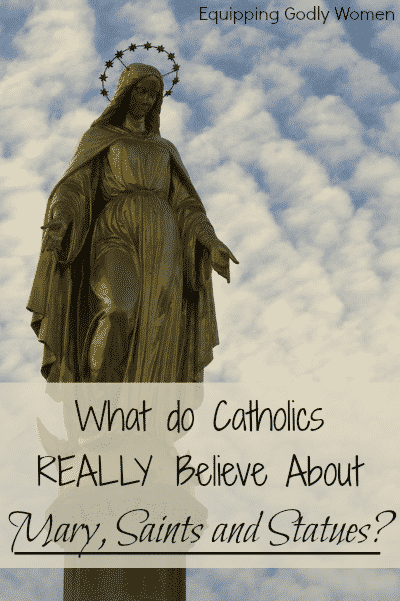
This post is post 8 in a series entitled Letting God Lead: My Journey Through Protestant and Catholic Beliefs. While you certainly can read this post by itself, I highly encourage you to check out the rest of the series as well. Find more about this series and a list of all of posts here. *This post contains affiliate links.
For many Protestants, some of the most difficult Catholic Church teachings to accept are the Church’s beliefs surrounding Mary and the Saints. I’m guessing this is due to the following reasons:
1. There’s a lot of misunderstanding about what the Catholic Church actually teaches
2. What individual Catholics do in practice doesn’t always match official Roman Catholic Church teaching.
3. It’s just *weird* to Protestants who grew up in a completely different culture
Now, I can’t speak as to what every individual Catholic does in practice. I’m new on the scene and only personally know a handful of Catholics. So, understand that that is not my intent. Instead, we’re going to talk primarily about official Catholic Church teaching so we can separate some of the fact from the fiction. What you do with it as an individual–well, that’s up to you.
[thrive_leads id=’23166′]
Do Catholics Worship Mary?
First of all, Catholics do NOT worship Mary. They think very highly of her and honor her (the word they use is “venerate” — which means hold in high regard or treat with great respect, more than you would to a king, but less than you would to God), but they do NOT worship Mary or think she is equal with God at all.
I can see why Protestants think Catholics do. They pray to her, they put up pictures of her, they say the Hail Mary, (some Catholics in some parts of the world DO mistakenly worship her)… BUT the official answer is: No, they do not.
Here’s my 2 cents on the issue: Worship is an attitude. It’s intentionally honoring someone as God. You can’t accidentally worship someone. For example, I like to worship by singing rockin’ praise and worship songs. That’s worship to me. If my 5 yo hears me, gets the song stuck in his head and then is singing it later, is he worshipping God too? Not really. Yes, he is honoring God, but he’s not really worshipping. He’s just singing a catchy song.
And really, if ANYTHING is worshipping someone, what about all the country love songs out there? There are tons of songs that go on and on and on about how wonderful and perfect and amazing a woman is. Are they worshipping? No. Because that’s not their intent. The singers think the woman is awesome, but they certainly don’t think she’s equal to God.
So, if a Catholic is praying to Mary or kissing the feet of a statue of her, are they worshipping? Not automatically. It really depends what is going on in their hearts and what they are intending to do. Are they trying to bring honor and respect to the person God himself honored more than anyone or anything else in all of creation? Or do they see Mary herself as their savior and God? There’s a HUGE difference there.
And as Catholics say: “You can never love Mary more than Jesus did.”
Hope that clears things up a bit.
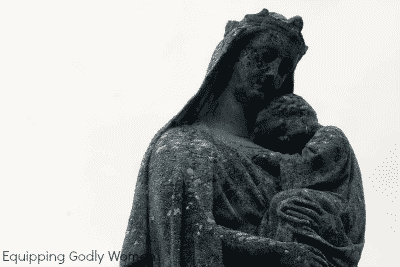
What Does the Catholic Church Teach About Mary?
Catholics believe Mary:
- was preserved from Original Sin (by God, not her own merits) and remained sinless throughout her entire life
- remained a virgin throughout her entire life
- is the new Eve
- is the mother of the Church
- is in Heaven already
- acts as an advocate or intercessor for Christians today
1. Mary was Without Original Sin
Catholics believe that Mary was conceived without original sin, not because she earned it or deserved it, but because God chose to preserve her from it in order that she would be a pure vessel for the Holy Baby she would later carry.
Q: But what about Romans 3:23 and 1 John 1:8, which say that all have sinned? Well, if ALL had sinned, that would include Jesus, since he was a man too. So “all” can’t mean “every single one without any exception.”
Q: But if Mary was sinless, why would she need a savior (Luke 1:47)? I love the analogy Bryan gave in the comments section of the 10 Common Catholic Myths Critics Believe post. I believe it originally came from Franciscan theologian Duns Scotus. Bryan wrote:
You’re walking along a road and fall into a deep hole. Someone comes along and drops down a ladder or rope and gets you out. They’ve saved you, correct? But your clothes are probably dirty and maybe have a few holes.
What if that same person where to shout at you BEFORE falling into the hole? Aren’t they still a savior? And look, your clothes are still clean!
That’s the Catholic view of Mary’s Immaculate Conception. In anticipation of the redemptive work of Christ, Mary was preserved by God in a special way from any stain of Original Sin. He kept her from ever falling into the hole.
Makes sense to me.
Now, I don’t believe you’ll find the belief that Mary was a virgin explicitly spelled out in the Bible. Like I said in the Who Has the Ultimate Authority? A Biblical Look at Sola Scriptura post, the Bible doesn’t cover every single question that could ever possibly come up throughout the entire rest of the world.
So, when the Bible doesn’t mention things, Catholics go back to what the first century Christians believed and passed down, and from what I understand Mary’s sinlessness was never seriously questioned for centuries. It was common knowledge and widely accepted. So when the Catholic Church officially declared it doctrine in 1854, they weren’t making up a new belief, they were simply formally defining something they had always believed.
2. Mary was a Perpetual Virgin
Protestants believe Mary was a virgin up through the time she gave birth to Jesus. Catholics believe she remained a virgin forever.
Q: But what about Matthew 13:55, which lists Jesus’ brothers? Apparently, the word we have for “brothers” in English could better be translated as “cousins.” Other verses list these same brothers as sons of another Mary.
Also, when Jesus dies, he entrusts his mother to the disciple John. If he had brothers and sisters, wouldn’t he entrust her to one of them?
Q: Then why does Matthew 1:25 say Mary was a virgin “UNTIL” Jesus’s birth? This is another example of a text that loses some of its meaning in translation. In the original language, “until” speaks of the time only *until* the event–it doesn’t reference anything that occurs *after* at all.
Another example would be 1 Corinthians 15:25, which says God will reign “until” He puts His enemies under His feet. Surely God won’t stop reigning once His enemies are under his feet.
Q: Then why is Jesus called the Firstborn? In the Bible, the term “firstborn” doesn’t mean “the child who was born first.” Instead it was the ceremonial title for the child who receives the birthright (think Jacob and Esau).
Q: Where is Mary’s Perpetual virginity mentioned in the Bible? Like her sinlessness, it’s not (to my knowledge). But, as I said before, the Church holds to all of the teachings of the apostles equally–both those that were written down (in the Bible) and those that were passed on orally (Sacred Tradition).
3. Mary is the New Eve
All Christians believe that Jesus is the new Adam (Romans 5:12-18); Catholics complete the analogy by viewing Mary as the new Eve. I have to admit, there are a ton of interesting parallels. This article has 6 Biblical Reasons Mary is the New Eve if you want to read more.
4. Mary is the Mother of the Church
Not that she created the church, but that she is a sort of mother figure. Kind of like Father Abraham to the Jews? I’m sketchy on the details, so if any Catholics want to leave more details in the comments section…. *hint hint* 🙂
5. Mary is in Heaven Already
Just a note–the Church is silent on whether or not Mary died first before she was taken up to Heaven, so Catholics are free to believe whichever way they want.
6. Mary Acts as an Intercessor
I’m going to lump Mary as an intercessor in with Saints as intercessors, so hang in there–we’ll get there! lol
***I also want to talk about the Rosary and the Hail Mary and all that, but I’m going to save that discussion for the post on “Weird Catholic Stuff,” scheduled for March 25th.
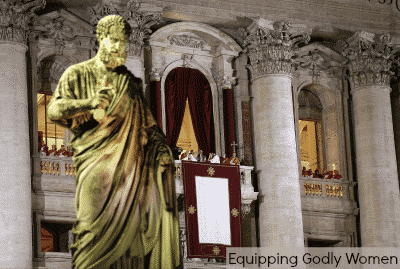
Why Do Catholics Pray to Saints?
When Protestants need prayer for something, they have two options: They can pray to God themselves, or they can ask others to pray for them. Catholics have a third option: In addition to praying to God directly or asking a friend or family member to pray for them, they can ask a Saint to pray for them as well.
Catholics base their prayers to the Saints on the following verses:
“And when he had taken it, the four living creatures and the twenty-four elders fell down before the Lamb. Each one had a harp and they were holding golden bowls full of incense, which are the prayers of God’s people.” –Revelation 5:8
“Therefore confess your sins to each other and pray for each other so that you may be healed. The prayer of a righteous person is powerful and effective.” –James 5:16 (And who is more righteous than those who are already in Heaven?)
Now, I want to point out–Catholics don’t believe that you HAVE to pray to Saints, or that it is better to pray to them than to God, and they don’t only pray to Saints. They just view it as an option that we have.
Also–another incredibly important point–Catholics (theoretically) don’t believe that the Saints actually have the power to DO anything. They are just asking the Saints to intercede for them–exactly like how Protestants ask their friends to pray for them. They believe that God is still the one who ultimately answers the prayers.
Catholics don’t pray TO the Saints, they pray THROUGH the Saints, or ask the Saints to pray on their behalf.
Although, honestly, as far as I can tell, this is one of those instances where what Catholics teach and what Catholics practice don’t entirely line up. For example, consider these two papers my son brought home from school.

I actually took these to a Catholic priest to ask, “How can Mary help us say yes to God and how can Saint Therese help us love God if they aren’t supposed to be able to actually DO anything?” His response was basically “Well, we believe they ask God to help us, not that they do it themselves.” So… then why doesn’t it say that? Because that’s not what these papers say at all.
And consider this article about Saint Anthony, Patron Saint of Lost Items. The lengthy prayer to Saint Anthony says: “O gentle and loving St. Anthony, whose heart was ever full of human sympathy, whisper my petition into the ears of the sweet Infant Jesus, who loved to be folded in your arms; and the gratitude of my heart will ever be yours.”
Several phrases come to mind like: “St Anthony please let my sweatpants be found soon! I believe in you!” “This Saint Anthony has never let me down when I call for his intercession with regard to lost or misplaced items.” and “Amanda credits Saint Anthony with their return from the sea!!”
Again, it’s important to keep in mind the distinction between what the Catholic Church actually officially teaches and what people do. Not to say that they are a bunch of people who say one thing and do another… (at least, not any more than any other Christian–we’re all guilty of this on occasion). Just to say–just because some people get things wrong doesn’t automatically mean that the official teachings themselves are wrong.
Q: Okay, so what about how the Bible says there is only one mediator–Jesus (1 Tim 2:5)? The Catholic Church does believe that Jesus is our one, true mediator. He’s the only one who can truly get the job done or make it even possible that we would have a relationship with God at all.
But Catholics also recognize that God’s people are called to take part in this mediation as well. In fact, the Bible commands it, using words like “intercession” or “intercede,” which mean the same thing.
“First of all, then, I urge that supplications, prayers, intercessions, and thanksgivings be made for all people” –1 Timothy 2:1
“And pray in the Spirit on all occasions with all kinds of prayers and requests.With this in mind, be alert and always keep on praying for all the Lord’s people.” –Ephesians 6:18
“for I know that through your prayers and God’s provision of the Spirit of Jesus Christ what has happened to me will turn out for my deliverance” –Phillipians 1:19
Protestants believe that Christians can and should pray for each other while they are here on this Earth. Catholics simply believe that the prayers don’t stop once the Saints die and go to Heaven. That the same Saints that prayed for people while on Earth continue to do so even now that they are in Heaven.
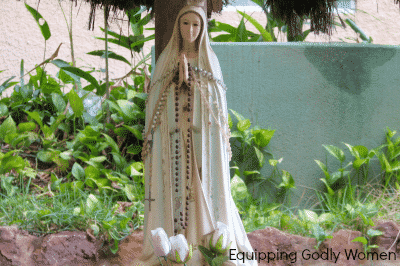
Why Do Catholics Have Statues?
While this issue generally isn’t nearly as big as the whole Mary/Saint debate, it is still quite a sticking point for many: Why do Catholics have statues? Isn’t that idol worship?
First of all, no, Catholics don’t worship statues any more than random city residents worship the statues in their towns. The Catechism of the Roman Catholic Church expressly forbids idolatry, and defines idolatry as following:
“The first commandment condemns polytheism. It requires man neither to believe in, nor to venerate, other divinities than the one true God. Scripture constantly recalls this rejection of ‘idols, [of] silver and gold, the work of men’s hands…” (2112)
“Idolatry not only refers to false pagan worship…Idolatry consists in divinizing what is not God. Man commits idolatry whenever he honors or reveres a creature in place of God…” (2113)
This is not how Catholics treat their statues. Here’s what you should find instead:
1. Statues are Used for Remembrance
Similar to how people put pictures of their friends and family members around their homes or on their fridge, statues allow Catholics to remember the Saints who have gone before and to be inspired to live up to the high standards they set for us.
2. They are Used for Teaching
Also–another thing that you need to remember is in the early days of the Church, people didn’t have copies of the Bible and–even if they had–they couldn’t read. Statues, pictures, icons the stations of the cross–all of these things were used as teaching tools, just like how Protestants have pictures of Jesus, nativity scenes, crosses with crowns of thorns, and felt boards with little felt Bible characters.
3. God Specifically Requested Statues in Worship
In Exodus 25, when God was laying out the instructions for the ark of the covenant, He called for it to have statues of Cherubim.
“And make two cherubim out of hammered gold at the ends of the cover. Make one cherub on one end and the second cherub on the other; make the cherubim of one piece with the cover, at the two ends. The cherubim are to have their wings spread upward, overshadowing the cover with them. The cherubim are to face each other, looking toward the cover.” — Exodus 25:18-20
If God specifically requested the ark of the covenant to be decorated with statues then, I highly doubt He is deeply offended by them now.
4. Old Testament History
And the ark isn’t the only time God called for statues either. In Numbers 21:8-9, God tells Moses to make a bronze snake, which the people look at to be healed. In Ezekiel’s vision in Ezekiel 41:18-20, he sees carved cherubim and palm trees.
Q: Why Do Catholics Remove the Second Commandment? If you look closely at the Protestant 10 Commandments and the Catholic 10 Commandments, you’ll notice something odd–they aren’t exactly the same. Commandment #2 about not worshipping idols is missing from the Catholic version.
BUT this isn’t because Catholics are trying to get rid of it. Instead, the New Testament account of the 10 Commandments doesn’t actually number them as ten. Instead, it lists 14 imperative statements, and–don’t forget–the original copies don’t include verse numbers. Therefore, commandments were grouped together, and Catholics (and Jews) simply group them differently than Protestants. All of the info is still there–just arranged a little differently.
Okay, so I hope that clears things up a little bit! What questions do you still have? What points did I miss? See you in the comments section below!!
Loving this series so far? Don’t forget to sign up for the Equipping Godly Women Newsletter for up-to-date info and behind the scenes sneak peaks!
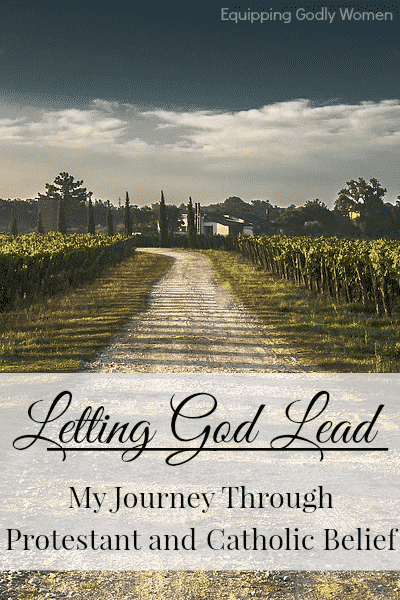
Enjoyed this post? Don’t miss the rest of the posts in the series!
The Day I Realized My Religion Got it Wrong
10 Common Catholic Church Myths that Critics Believe
Is the Eucharist Really Just a Symbol?
Who has the Ultimate Authority? A Biblical Look at Sola Scriptura
A Brief Look at the History of Christianity
What All Christians Should Know About Priests, the Pope and Confession
What Do Catholics Really Believe About Mary, Saints and Statues?
Infant Baptism or Believer’s Baptism? Which is Correct?
What is Purgatory? What are Indulgences?
Why Do Catholics….? Honest Answers to Your Burning Questions
Protestant and Catholic Beliefs Series Conclusion
Resources and Further Reading
I’m not asking you to believe because I say so. Please DON’T take my word for it! The purpose of this series is only to share what I’ve learned on my journey in order to inspire you to begin a journey of your own. Here are a few helpful resources to get you started.
*This post contains affiliate links, which means if you make a purchase, I may make a small commission at no additional cost to you. Thank you!
Catechism of the Catholic Church
Surprised by Truth: 11 Converts Give Biblical and Historical Reasons for Becoming Catholic by Patrick Madrid
The Catholic Church: What Everyone Needs to Know by John L. Allen
https://www.catholic.com/tract/do-catholics-worship-statues
https://www.catholic.com/tract/praying-to-the-saints
http://www.catholicscomehome.org/two-minute-answers/
http://www.gotquestions.org/intercessory-prayer.html
http://www.gotquestions.org/prayer-saints-Mary.html


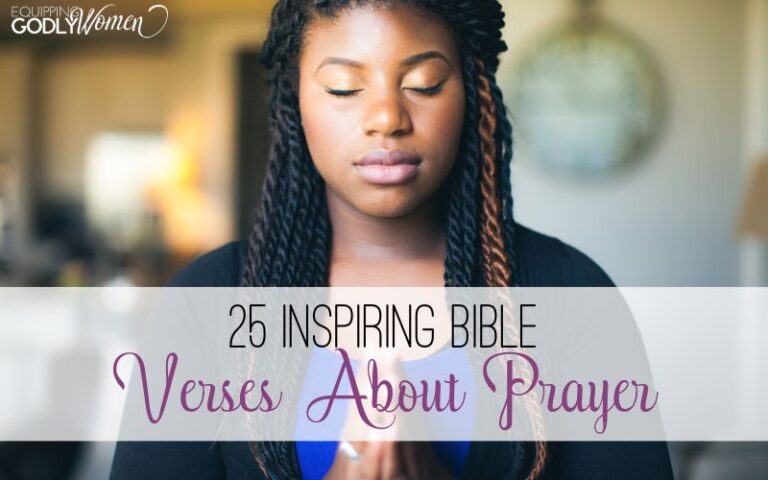


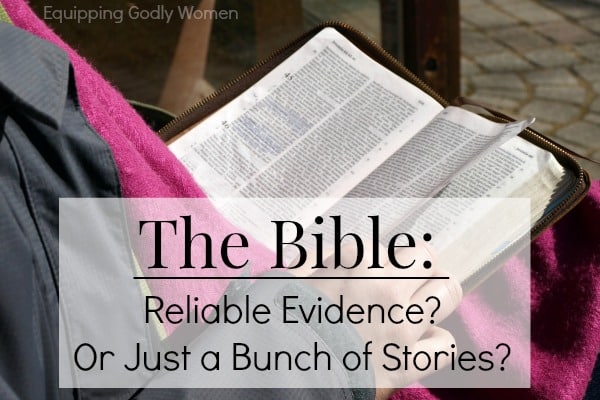


Hello,
I just read your article and there are some glaring mistakes on what you have been told some scripture says/mean. I’ll just take one for instance:
Regarding Mary being an ever-virgin: Matt: 1:25 and 1 Cor 15:25. The word “until” in both these verses DO mean the end of something. You write “Another example would be 1 Corinthians 15:25, which says God will reign “until” He puts His enemies under His feet. Surely God won’t stop reigning once His enemies are under his feet.” I am assuming you mean the Father in your statement. But the verse reads the following and I will include v.24 to help the context:
“24 Then the end will come, when He (Jesus) hands over the kingdom to God the Father after He (the Father) has destroyed all dominion, authority, and power. 25 For He (Jesus) must reign until He (the Father) has put all His (Jesus) enemies under His (Jesus’) feet. ” Names in parentheses added by me.
When you examine and know who He and He are and consider the context you see that JESUS hands over His reign to the FATHER (cross ref with Psalms 110:1). Yes, Jesus was given “all authority and dominion” Matt 28:18 and currently reigns but that does not last forever. 1 Cor 15:24 tells us that Jesus’ CURRENT reign will end (hands authority and dominion back to the Father) and a new age AND reign will begin.
So your example actually disproves your belief.
God bless you.